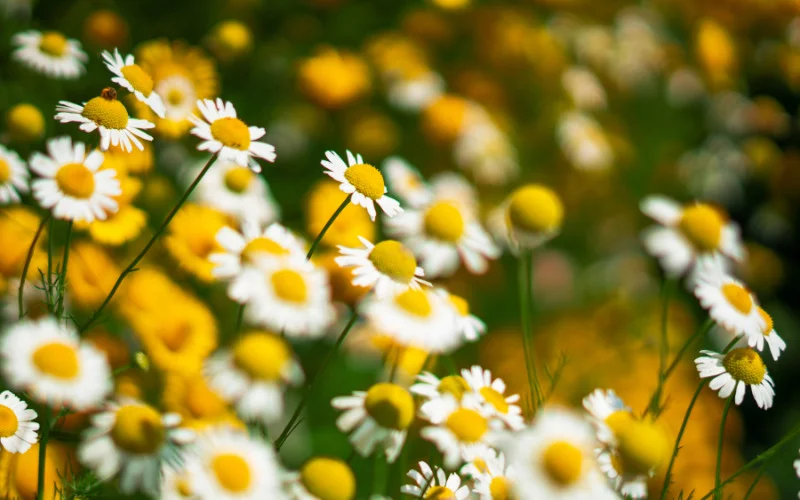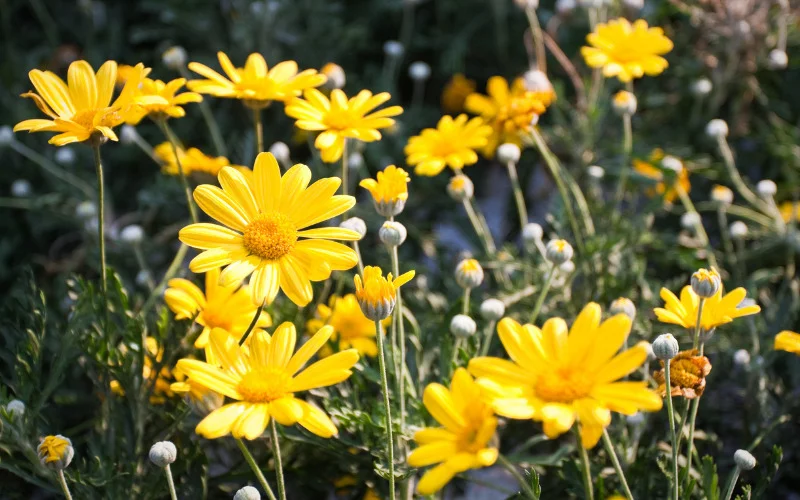Yellow daisies are one of the easiest flowers to grow and maintain. This gives you an opportunity to decorate your yard with little work being done.
Even while yellow daisies may be easy to grow, you must know the necessary steps involved in this process. Once you get the outset right, maintenance becomes easy.
This article will give a detailed guide on how to plant daisies from seeds and how to plant daisies from root balls. We will also look at some care tips for daisies in your garden.
About Yellow Daisies
Yellow daisies can be as tall as 40 inches and 7 inches wide. They usually grow in the past and bloom during the summer, specifically between June and August.
This perennial flower has a bright yellow color that fully radiates your summer garden. Daisies are native to Europe, Africa, and North America. These flowers exist in 6 different species.
How To Grow Yellow Daisies in Your Garden

You can grow daisies in your garden by directly planting the seeds or transferring an already grown yellow daisy flower to your garden.
You can get an already grown daisy flower from a nursery. Below are the steps required to grow daisies in your garden, either by direct planting or transfer.
1. How to Plant Daisies from Seed
When growing daisies from seed, you should expect the flowers to bloom the following year.
Daisy seeds are usually planted during spring when temperatures hit exactly 70° Fahrenheit. The following steps should guide you on how to plant daisy seeds.
a. Prepare The Soil
It is important to give your daisies the best soil even though they are low maintenance; a good soul will facilitate their growth.
Your soil needs to be loosed, and this can be done using a tiler. You should also mix some inches of the soil with fertilizer as the perfect soil for daisies is well-drained and moist loamy soil.
An ideal soil for daisies should be a mixture of sand, moss, and manure, but you should know that even if you don’t have the required soil, daisies adapt easily to most oil types and will still grow under different conditions.
b. Planting the Seeds
Daisy seeds should be planted in a sunny spot, and the seeds should be covered with 8 inches Of soil to allow room for sunlight.
Water the soil regularly, and germination should occur within 10-20 days.
Some people prefer to grow daisies in a pot; you will still need the same soil type for this process. When planting your seeds, do not push them into the soil, instead, keep the seeds at the soil’s surface and use about 8 inches of soil to cover the soil.
2. Planting Daisies from Root Balls
If you are not patient enough to wait for seedling daisies to bloom, you can always get a grown daisy flower that has already bloomed; then, you can transfer it to your garden or flower pot.
As usual, use rich soil to grow your daisies as it is essential for growth. Prepare a space in your garden for the daisies by digging a hole that is twice the diameter of your daisy plant, the pot included. Daisies grow fast, and enough space is needed for the roots to grow.
Always water daisies at the base; this prevents diseases. Daisies do not grow well in soggy soil, so ensure that the soil is well-drained before watering it again.
How to Care for Daisies in Your Garden
The process of caring for daisies is easy; all you have to do is follow these easy tips.
- Support your daisies with posts because some of these flowers may grow tall and will be bent by wind action.
- Propagate daisies by dividing. Every year, daisies bush gets larger and larger, and when this happens, the roots overcrowd each other leading to the withering of some parts of the plants. You need to dig up the bush and cut out the dead parts and their corresponding roots to fix this. Divide the remaining plant and root and grow them 12 inches away from the initial daisy flower. This process should be done often to keep your daisies healthy.
- Deadhead flowers to promote growth. Daisies bloom multiple times a year, and when you cut off the head of dead flowers, you will encourage more growth and blooming.
Recommended Daisy Varieties
There are other varieties of daisies aside from the yellow daisies that can be used to add more color to your garden. And with only little maintenance, these flowers will be a great collection for your garden.
1. Shasta Crazy Daisy
Shasta daisy produces the usual daisy blooms and can grow as wide as 3 inches. These flowers are known for their carefree nature. This daisy is a perfect fit for your perennial garden.
2. Painted Daisy
This variety of daisies comes in red, yellow, pink, white, and purple. These flowers attract birds and make your garden look like a scene from a Disney movie. You will need these vibrant colors in your garden.
3. Echinacea Pink Shimmer
This flower grows up to 3 to 5 inches wide and will add vibrant pink color to the garden. You don’t need a serious amount of care for pink shimmers, so this should act as a regular daisy.
4. Osteospermum or Blue-eyed Beauty
This variety grows the usual daisy bloom, but it has a purple center. This perennial flower is a must-have in your garden as it will add more color to what you already have.
5. Barberton Daisy
This flower comes in different colors, including red, orange, pink, and yellow. This variety can have a single and double bloom.
6. Oxeye Daisy
If you love wildflowers, then you will love this variety. They usually grow on fields, but they can spread out in your garden, creating a colorful view.
Conclusion
Yellow daisies would look great in your garden; these perennial flowers add radiant yellow color to your garden.
Daisies need enough sunlight, so don’t bury the seeds too deep into the soil when growing these flowers. They also don’t grow well on soggy soil, so ensure that your soil is healthy and well-drained.
To care for yellow daisies, propagate these flowers regularly, deadhead the flower heads, and support the flowers if they grow too tall. We have also recommended other varieties of daisies if you consider growing other species.
Helpful Links:
- Can You Compost Pineapple?
- Do Acorns Kill Grass
- How Do You Grind Compost?
- Can I Compost Any Material I Find?
- How Do I Get Rid of Mushrooms in My Garden Bed?
We trust this article helped you know How to Grow Yellow Daisies in Your Garden. You may also want to check out If You Should Mix Grass Seed with Topsoil?
Thanks for taking the time to read our article, and we hope you find it helpful. Would you mind leaving a comment below if you have any suggestions?
Kindly reach out to people by sharing this post on social media.
If you liked this article, then please follow us on Facebook, Instagram, and Pinterest.

